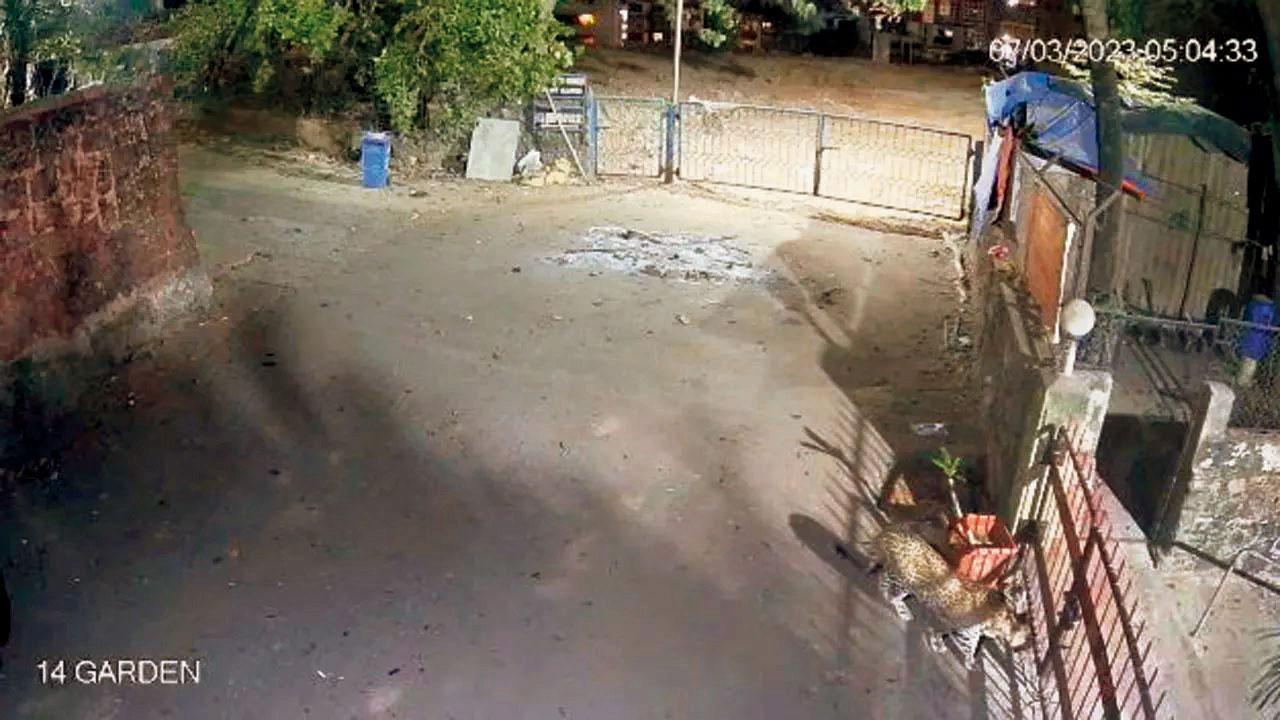Study shows numbers in central India have grown but the Shivalik Hills and Gangetic plains have declined

A leopard caught on the CCTV camera of a housing society at Bhavani Nagar, near Aarey Milk Colony
Maharashtra has the second highest leopard population in the country, according to a recent report. The findings come as good news to wildlife lovers but also highlight the importance of keeping the forest cover intact. The ‘Status of Leopards in India’ report released on Thursday estimated India’s leopard population at 13,874 (range: 12,616-15,132), representing a stable population in comparison to the findings of in 2018 which found 12,852 (12,172-13,535) leopards in a similar survey area.
Wildlife Institute of India (WII) Director Virendra Tiwari told mid-day that Madhya Pradesh houses the largest population of leopards in the country with 3,907 of the big cats, followed by Maharashtra with 1,985 in 2022. In 2018, the two staTes recorded leopard populations at 3,421 and 1,690, respectively. This all-India estimate of 13,874 represents 70 per cent of the leopard habitat as the Himalayas and semi-arid parts of the country which are not tiger habitats were not sampled.
ADVERTISEMENT
As per the estimates, Central India shows a stable or slightly growing population of leopards (2018: 8,071; 2022: 8,820) while Shivalik Hills and Gangetic plains witnessed a decline (2018: 1,253; 2022: 1,109). Areas sampled across India in 2018 witnessed 1.08 per cent per annum (pcpa) growth by 2022 while the Shivalik Hills and Gangetic plains saw a 3.4 pcpa decline in numbers. The largest growth rate, of 1.5 pcpa, was recorded in central India and the Eastern Ghats.
Also Read: How elephants grieve and bury their dead
After MP and Maharashtra, Karnataka takes the third spot with a leopard population of 1,879 in 2022 (up from 1,783 in 2018), followed by Tamil Nadu (2022: 1,070; 2018: 868). Tiger Reserves or forest sites with the highest leopard population are Nagarajunasagar Srisailam (Andhra Pradesh), followed by Panna (MP), and Satpura (MP).
According to the Ministry of Environment, Forest and Climate Change, the fifth cycle of leopard population estimation (2022) in India focused on forested habitats within 18 tiger states, covering four major tiger conservation landscapes. Non-forested habitats, arid, and high Himalayas that are 2,000 metres above sea level and account for 30 per cent of the land area were not sampled for leopard populations.
The study also included a foot survey spanning across 6,41,449 km to estimate carnivore signs and prey abundance. Camera traps were strategically placed at 32,803 locations, resulting in a total of 4,70,81,881 photographs, with leopards being pictured 85,488 times.
The findings underscore the critical role of protected areas in conserving leopard populations. While tiger reserves serve as important strongholds, addressing conservation gaps outside protected areas is equally vital. Rising incidents of man-animal conflict pose challenges for both leopards and communities. Since leopard survival outside protected areas is equally important, collaborative efforts involving government agencies, conservation organisations, and local communities are essential to enhance habitat protection and mitigate human-wildlife conflict.
Expert Speak
Wildlife conservationist Kedar Gore from The Corbett Foundation said leopards are incredible creatures, surviving on a variety of prey from jungle fowl to sambar deer and the free-ranging dog. “The big cats can survive in a wide range of habitats, from sugarcane fields to dense forests. This adaptability makes them perfect candidates for the 'survival of the fittest' award. Project Tiger has benefitted leopards, too, and they have occupied the niche of being top predators in areas where tigers are not found.”
Gore said an increase in numbers indicates the success of the conservation programmes, but it is also a matter of concern, especially in areas where leopards have a high population density around human-dominated landscapes. Mumbai's SGNP is a classic case where the leopard density is the highest in the world. “Such large populations bring in their set of problems, such as frequent negative interactions between humans and leopards. We now need to urgently plan measures to make sure this coexistence remains harmonious. This is easier said than done and will need discussions on adopting non-lethal measures for controlling the populations of leopards, keeping in mind the carrying capacity of the area,” Gore said.
Bombay Natural History Society (BNHS) Director Kishor Rithe, said, “The leopard population is stable and not increasing like tigers as leopards live around human habitation and hence are more vulnerable to threats like poaching, poisoning and accidental deaths due to linear infrastructure.”
1,985
No of Leopards in state (2022)
 Subscribe today by clicking the link and stay updated with the latest news!" Click here!
Subscribe today by clicking the link and stay updated with the latest news!" Click here!








